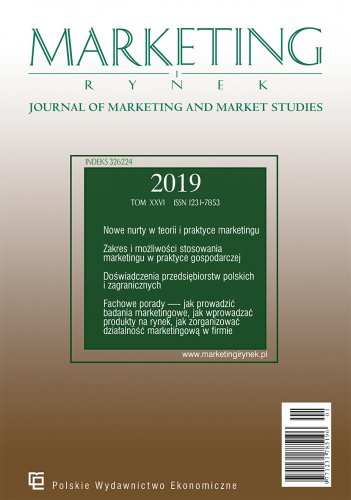Quality of dance school services — marketing implications
The article is of a research nature. It aims to identify the most important factors determining the quality of services offered by dance schools. To achieve the set goal, the SERVQUAL method was used. This method allows determining the most desirable features of dance schools by the students and combines them into several categories: "specifics", "reliability", "willingness to cooperate", "certainty", "empathy". These features form the five dimensions of service quality and decide whether the customer will accept the company's offer. They are also the foundation of the process of building customer satisfaction of every service company. The results of the research obtained on a nationwide sample of 265 participants of dance schools indicate that among the surveyed dimensions, "certainty" and "reliability" are the most important for the respondents. On the other hand, the most irrelevant is "empathy". The presented results, despite the limitations resulting from the lack of full representativeness of the sample and the used technique (online survey), in the author's opinion may be a support and great source of information for managers of dance schools and be a contribution to the continuation of research in the undertaken area.
References
Bibliografia/References
Aron, A., Aron, E. N. i Coups, E. J. (2009). Statistics for Psychology. Fifth Edition, London: Pearson International Edition.
Bielawa, A. (2011). Przegląd najważniejszych modeli zarządzania jakością usług. Zeszyty Naukowwe Uniwersytetu Szczecińskiego, (24), 7–23.
Czubała, A., Jonas, A., Smoleń, T. i Wiktor, W. (2006). Marketing usług. Kraków: Wolters Kluwer.
Czubała, A., Jonas, A., Smoleń, T. i Wiktor, W. (2012). Marketing usług. Warszawa: Oficyna Wolters Kluwer Business.
Dąbrowska, A., Bylok, F., Janoś-Kresło, M., Kiełczewski, D. i Ozimek, I. (2015). Kompetencje konsumentów: innowacyjne zachowania, zrównoważona konsumpcja. Warszawa: PWE.
Frąś, J. (2014). Wybrane instrumenty pomiaru jakości usług logistycznych. Zeszyty Naukowe, Uniwersytetu Szczecińskiego, (66), 297–317.
Gierczak, B. (2015). Jakość usług turystycznych w transporcie lotniczym w opinii pasażerów PLL LOT. Folia Turistica, (35), 45–64.
GUS (2017a). Uczestnictwo w sporcie i rekreacji ruchowej w 2016 r. Warszawa: GUS.
GUS (2017b). Rocznik Statystyczny Rzeczypospolitej Polskiej. Warszawa: GUS.
Harry, M. i Schroeder, R. (2001). Six sigma wykorzystanie programu jakości do poprawy wyników finansowych. Kraków: Dom Wydawniczy ABC — Oficyna Ekonomiczna.
Henson, R. K. (2001). Understanding internal consistency reliability estimates: A conceptual primer on coefficient alpha. (Methods, plainly speaking). Measurement and Evaluation in Counseling and Development, 34(3), 177–189. https://doi.org/10.1080/07481756.2002.12069034
Jaciow, M., Kolny, B., Maciejewski, G., Mikołajczyk, B. i Wolny, R. (2015). Services in Europe — Diagnosis and development perspectives. Katowice: Wydawnictwo Uniwersytetu Ekonomicznego w Katowicach.
Kędzior, Z. (red.). (2005). Badania rynku. Metody zastosowania. Warszawa: PWE.
Kolny, B. (2013). Rynek usług zagospodarujących czas wolny — diagnoza i perspektywy. Katowice: Wydawnictwo Uniwersytetu Ekonomicznego w Katowicach.
Kotler, Ph. (2012). Marketing. Poznań: Dom wydawniczy Rebis.
Kurkowski, B. (2019). Leisure in Well-Being. Optimum Economic Studies, 3(97), 49–61. https://doi.org/10.15290/oes.2019.03.97.04
Lauren, P. i Lin, H. (2003). A Customer Loyality Model for e-service context. Journal of Electronic Comerce Research, 4(3), 156–167.
Lewandowski, R. (2008). Pomiar Jakości usług medycznych z wykorzystaniem metody SERVQUAL. Problemy Jakości, (9), 30–35.
Maciejewski, G. (2012). The Contemporary Consumer in the Face of Megatrends in Consumption. W: A. Olejniczuk-Merta (red.), The Transformation of Consumption and Consumer Behaviour, (27–42). Warszawa: IBRKK.
Maghsoodi, A. I., Saghaei, A. i Hafezalkotob, A. (2019). Service quality measurement model integrating an extended SERVQUAL model and a hybrid decision support system. European Research on Management and Business Economics, 25(3), 151–164. https://doi.org/10.1016/j.iedeen.2019.04.004.
Markosian, N. (2014). Time, Stanford Encyclopaedia of Philosophy (online). CSLI, Stanford University.
Marzec, M. (2012). Wymiary zaufania w procesie świadczenia usług, Ekonomiczne Problemy Usług, (95), 37–49.
Mroz, B. (2013). Konsument w globalnej gospodarce. Trzy perspektywy. Warszawa: Oficyna Wydawnicza SGH.
Muller, H. (2004). Qualitätsorientiertes Tourismus-Management. Bern: Haupt.
Morgan, B. (2019). The customer of the future. Nashville: HarperCollins Leadership.
Mynarski, S. (2002). Mechanizmy funkcjonowania układów rynkowych. Zeszyty Naukowe, Akademii Ekonomicznej w Krakowie, (605), 7–23.
Parasuraman, A., Zeithaml, V. A. i Berry, L. L. (1985). A Conceptual Model of Service Quality and Its Implications for Future Research. Journal of Marketing, 49(4), 41–50. https://doi.org/10.1177/002224298504900403
Prentkovskis, O., Erceg, Ž., Stević, Ž., Tanackov, I., Vasiljević, M. i Gavranović, M. (2018). A New Methodology for Improving Service Quality Measurement: Delphi-FUCOM SERVQUAL Model. Symmetry, 10(12). https://doi.org/10.3390/sym10120757
Pięta, J. (2014). Pedagogika czasu wolnego. Warszawa: Wydawnictwo FREL.
Raza, S. A., Umer, A., Qureshi, M. A. i Dahri, A. S. (2020). Internet banking service quality, e-customer satisfaction and loyalty: the modified e-SERVQUAL model. The TQM Journal, 32(6), 1443–1466. https://doi.org/10.1108/TQM-02-2020-0019
Rogoziński, K., Kuczyński, J. i Cieloch, G. (1992). Czas wolny — czasem konsumpcji. Warszawa: PWE.
Shimizu, A. (2021). New consumer behavior theories form Japan. Singapore: Springer. https://doi.org/10.1007/978-981-16-1127-8
Skowron, Ł. i Gąsior, M. (2017). Motywacja pracownika a satysfakcja i lojalność klienta. Warszawa: Wydawnictwo Difin.
Sobczyk, G. (2018). Consumer behawior towards new consumption trends: research results. Annales Universitatis Mariae Curie-Skłodowska. Sectio H Oeconomia, (2), 171–180. https://doi.org/10.17951/h.2018.52.1.171
Stanton, W. J. (1993). Fundamentals of Marketing. New York: McGraw-Hill Education.
Stoma, M. (2012). Modele i metody pomiaru jakości usług. Lublin: Q&R Polska.
Tatarczuk, M. (2010). Klient na rynku usług oferowanych przez szkoły tańca. Problemy Zarządzania, Finansów i Marketingu. Zeszyty Naukowe Uniwersytetu Szczecińskiego, 609(16), 69–78.

